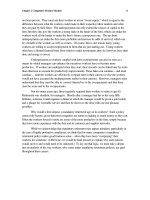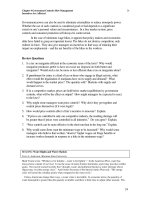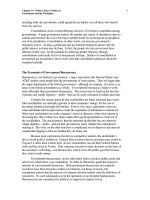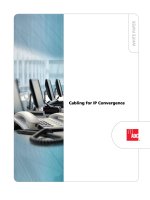Tài liệu Explanations for SAT 2 pdf
Bạn đang xem bản rút gọn của tài liệu. Xem và tải ngay bản đầy đủ của tài liệu tại đây (74.51 KB, 7 trang )
Explanations – SAT Practice Test 3
VERBAL
1. D Since the veteran boxer won most of his bouts by knockouts, you can assume
that he was pretty successful. Unbroken is the only choice that describes his
series of wins in a way that suggests success; an unbroken series of victories
would be a winning streak with no losses. (A) and (B) are both contradicted by
the rest of the sentence. Choice (C) able-bodied may seem to fit in a sentence
about a boxer, but what’s an able-bodied series of wins? This choice sounds
odd when you plug it in. Only (D) makes sense.
2. E Sitting still for hours and remaining alert to the slightest sound or motion
amounts to having (E) limitless patience and keen powers of observation.
Powers of (A) persuasion, (C) reasoning, or (D) trust have nothing to do with
the description of bird watching given. In (B), powers of concentration are
certainly required but it doesn’t make sense to speak of patience as skilled.
3. B One of the main things with Sentence Completions is to look for context
clues—words and ideas in the sentence that strongly suggest the answer you’re
looking for. Here, the first major clue in the sentence is the word “everyday.”
You know you’re looking for a word with a similar meaning for the first blank.
In the second blank, you need something to describe what the everyday objects
were transformed into, a word to contrast with “everyday.” That takes you to
(B). Mundane is almost a synonym for “everyday.” The second word in (B),
resplendent, or extraordinary, is a good contrast, and fits when plugged into the
sentence: Weston’s camera transformed mundane things into objects of
resplendent beauty. (C) and (E) can be eliminated because their first words
don’t work. Everyday things like vegetables are not always small or artificial.
In (A), inexpensive might seem to fit with the idea of “everyday items such as
vegetables.” But (A)’s second word, tawdry, or cheap and gaudy, makes no
sense. In (D), you might imagine that vegetables can be decorative, but (D)’s
second word functional doesn’t provide the contrast we’re looking for.
4. B Here, you know that the issues “go far beyond” the immediate controversy
referred to in the sentence. So you can predict they have “implications” or
“consequences” beyond the matter presently under discussion. The best match
for this prediction is (B) ramifications. Ramifications are resulting
developments or consequences. (C) proponents are advocates or supporters.
(D) inferences are conclusions.
5. D The phrase “even accepting” in the second part of the sentence implies that
Chamberlain’s approach to German aggression was not a particularly tough or
militant one, especially since he tolerated Germany’s annexation of Austria.
Therefore, it’s likely that Chamberlain adopted a non-aggressive, accepting
For more material and information, please visit Tai Lieu Du Hoc at www.tailieuduhoc.org
approach to Hitler. The choice that comes closest to this prediction is (D)
conciliatory, meaning “tending to pacify or accommodate.” Choice (B)
precarious means “uncertain or dangerous,” and choice (C) haughty means
“arrogant, snobby, huffy.”
6. C Although we don’t know what kind of performance Redgrave gave, we can
infer that it was either good or bad. If it was good, we can predict people who
were lucky enough to see the performance say it was the height of his career.
Basically, we want two positive words if Redgrave did a good job, or two
negative words if he bombed. The only choice showing this relationship is (C):
those fortunate enough to witness Redgrave’s performance say it was the
pinnacle, or height, of his career. (A) scourge means “something that annoys or
destroys.” (B) astute means shrewd or perceptive. (D) hapless means “unlucky.”
(E) nadir means “the lowest point.”
7. C This woman relieves her after-work exhaustion by walking along the beach.
Thus the implied adjective in the first blank, describing the sea air, will
reinforce this idea. In the second blank, we need a synonym for “relieve.’’
Thus (C): the bracing, or invigorating, sea air always manages to alleviate her
fatigue. The other choices make no sense. The sea air might be (A) humid, (B)
salty, (D) damp, or (E) chilly, but those qualities wouldn’t hasten, exacerbate
(worsen), reprove (scold), or aggravate the woman’s exhaustion.
8. A The word in the blank will describe terms which refer indirectly to some thing
or idea. The right answer is (A) — euphemisms are polite, inoffensive or less
explicit terms which are used to name an unpleasant, frightening or offensive
reality. "Passed away" is an example of a euphemism. You say “passed away”
instead of “died.” (B) banalities are things that are commonplace or worn-out.
(D) apostrophes are marks used to indicate the omission of one or more letters
in a word, as in the word “can’t.” (E) eulogies are formal speeches of praise.
At a funeral, speakers might deliver eulogies about the person that died.
9. E A good vocabulary will help you figure out this one. The bookkeepers altered
some financial records and completely fabricated others, so you need a word
like “altered,” “falsified,” or “fake” for the blank. (E) spurious means “false,
lacking authenticity,” so it’s a good match.
10. D ANCHOR is being used as a verb here. You can tell because some of the first
position words in the answer choices can only be used as verbs, and if one of
them is a verb, then all of them are verbs. To ANCHOR a BOAT is to secure it
in one place. Likewise, to tether a horse is to secure him in one place. Hope
you weren’t fooled by same subject temptations—in choices (A) and (B), the
words ship and pier might remind you of the stem pair, but that isn’t a good
reason to pick them.
For more material and information, please visit Tai Lieu Du Hoc at www.tailieuduhoc.org
11. C The related prefixes CO-, COL-, and COM- mean “with” or “together.”
COLLABORATE contains the prefix CO- and the root LABOR, so it means
“to WORK together.” The word habit has come a long way from its root,
HABIT, over the centuries, but the original root meaning is still visible in such
words as inhabit, habitat, and habitation. In those words, HABIT means “to
live or reside.” So cohabit means “to live together,” and (C) is correct. In (D),
SYN-, like CO-, means “with” or “together”; CHRON- means “time.” So
synchronize means “to make happen at the same time.” When one watch is
synchronized with another, it displays the same time as the other watch. But
watch in choice (D) isn’t a noun, it’s a verb. Always “watch” the parts of
speech in an analogy to make sure you understand what meaning of a word is
intended.
12. E In questions where the vocabulary is easy it is very important to state the
connection between the stem words absolutely precisely. In this case an
APRON is worn to protect one’s CLOTHES. Once this is clear, answer choice
(E) jumps out as correct: a helmet is worn to protect the head. The other
answer choices, even those with strong bridges, can be eliminated easily: (A)
is strong—a parasol is used to protect against the sun—but that bridge is
inappropriate. (B) is moderately strong: gloves are sometimes worn to protect
against the cold; since this bridge is identical to that in (A), both answer
choices would have to be eliminated because only one answer can have the
same bridge as the stem words. (C) and (D) have totally different bridges—so
(E) is the correct answer.
13. B Answer choice (B) is correct. A PULPIT is a platform on which a PREACHER
stands in church when addressing the congregation. In (B), the podium is a
raised platform where the conductor stands. Choice (A) has a strong bridge—
every teacher has a student—but it is not the one which we need here. Choices
(C), (D) and (E) can be eliminated because they have weak bridges: an artist, if
he or she is a painter, may use a canvas (C) but the connection is not a really
strong one; (D) and (E) are even weaker. In (D) a gallery is a balcony in a
theater.
14. A Here’s a tougher stem pair, but, as always, there is a strong bridge: The word
ADULATION is a very strong kind of PRAISE. In the same way, with (A),
loathing is a very strong kind of dislike. (B) doesn’t work because disdain and
contempt mean practically the same thing. The stem pair involves one word
that’s an extreme form of the other. Scholarship is not an extreme kind of
eloquence (C). Sympathy is not an extreme kind of emotion (D). And pleasure
is not an extreme form of hedonism. If you had trouble, you might have tried
eliminating choices—(C) and (D) both seem like weak bridges (words with
unclear relationships)—and then guessing.
15. B An ANALGESIC is used to relieve PAIN. Likewise, an emollient is used to
relieve dryness. There were a lot of “doctor” words here—especially in
For more material and information, please visit Tai Lieu Du Hoc at www.tailieuduhoc.org
choices (D) and (E). You might have spotted them as SST’s (same subject
temptations), especially since this was supposed to be a tough question. On
tough questions, the ones at the end of the set, the “obvious” answer is usually
wrong. In (A), a purgative is a medicine that purges or cleans you out, like
mineral oil. But a purgative doesn’t produce purity, exactly. In (C) a
humidifier provides moisture, not ventilation (air circulation).
Medical Pair
Although these two passages discuss issues in medical research, don’t be
intimidated by the subject matter. Read through the passages once to get a
general feel for them. The question stems will direct you back to the specific
sentences you’ll need to understand to get the answers. Also, it’s a good idea to
read through Passage 1 and do the questions that refer to it, and then read
through Passage 2 and do the rest of the questions.
Passage 1 talks about the difficulty of reconstructing or replacing certain bones
in humans. A recent advance has been the creation of bone substitutes from
muscle using the protein osteogenin. While osteogenin can’t be used directly on
a defect, it can be used to prefabricate bones in molds implanted in an animal’s
abdomen. The process hasn’t been tried in humans, though, because osteogenin
is scarce, and because it has to be tested on larger animals first.
Passage 2 has a distinctly different tone. The author is not objective and
impartial; he’s taking a stand on an issue: he argues that testing on humans is
necessary in order to make improvements in artificial organs. Using animals, he
says, isn’t good enough: there are no good animal models for human bones and
joints. Moreover, testing on humans gives doctors crucial experience. The
author concludes that there’s no point in developing new designs for artificial
organs until present ones have been evaluated on people.
16. D Remember to read the sentences before and after the line reference. At the end
of paragraph 1, the author talks about the difficulty of reconstructing and
replacing bones. This is the “challenge” that’s further explained in paragraph
2—(D) is the answer. The author doesn’t mention tissue development in the
human embryo until paragraph 3 (A). (B) contradicts the passage: the author
states that it ’s impossible to reconfigure bones. It’s currently possible to
replace joints with plastic or metal substitutes, but the author never says
anything about designing better types of them (C). She never identifies “the
causes of diseases that lead to bone losses” (E) either.
17. E The stem contains no line reference, but the only place the author talks about
future experiments in making bone from muscle is the last paragraph. She says
there that surgeons “have not yet tried the process in humans” and that it “must
For more material and information, please visit Tai Lieu Du Hoc at www.tailieuduhoc.org
first be tested on larger animals.” The author expects, therefore, that future
experiments will “involve larger animals and perhaps humans” (E). There’s no
evidence that future experiments will “encounter no serious problems” (A), that
they will be hindered by surgeons (C), or that they “face enormous technical
obstacles” (D). And despite the fact that all experiments have so far been
limited to smaller animals (B), it’s clear that this isn’t what the author expects
in the future.
18. C An example of the all/EXCEPT question type. Information about osteogenin is
spread over the last three paragraphs, so scan through the choices to see if one
jumps out before you start digging through the passage. (C), “its application
can be easily controlled,” should strike you as false because the author says in
paragraph 4 that osteogenin is hard to control—it might turn an entire area to
bone if sprinkled on a defect. If you didn’t spot (C), you had to confirm the
other choices. “Current supplies [of osteogenin] are limited” (A) is indicated in
paragraph 6. This is also where the author says that “tests of its effectiveness
have been limited” (B) to small animals, and that osteogenin’s “safety for
human use is undetermined” (D). The fact that “some surgeons hesitate to use
it” (E) because it’s hard to control is stated in paragraph 4.
19. A You’ve already had to go back and read through the last paragraph a couple of
times by now, so glance through the choices. “A review of current knowledge”
(A) looks good right away, because the author points out in the last paragraph
how far surgeons have gone in experimenting with and learning about the new
process. There’s no “qualification of an earlier remark” (B). (C) is out because
the author never mentions, no less challenges, a contradictory view. The final
paragraph presents new facts and ideas rather than a “summary of previous
ideas” (D). As for (E), the author’s call for testing on larger animals is a
demand not “for an alternative approach” but for a guarantee of safety and
effectiveness before the process is tried on people.
20. D The phrase “to die young at a ripe age” doesn’t make much sense until you
understand its context. The author’s discussing the eventual benefits of
artificial organs: ordinary people can live longer or, even better, they can die
young at a ripe age. “Dying young at a ripe age” does not mean “living longer”
(E). Nor does it mean “dying prematurely” (A), “dying young of an illness”
(B), or “extending one’s life despite being ill” (C)—none of these is a positive
thing—the author’s talking about the benefits of artificial organs. “Dying
young at a ripe age” means dying at a normal old age after having enjoyed a
relatively young body during your life; in other words, it means “maintaining a
healthier body into old age” (D).
21. C In paragraph 2 of Passage 2, the author accuses medical ethicists of hampering
the activities of human volunteers. He declares that the ethicists are “well-
intentioned” but “their standards are inappropriate.” Clearly, the author is
For more material and information, please visit Tai Lieu Du Hoc at www.tailieuduhoc.org









